|
Austria 1519-1699
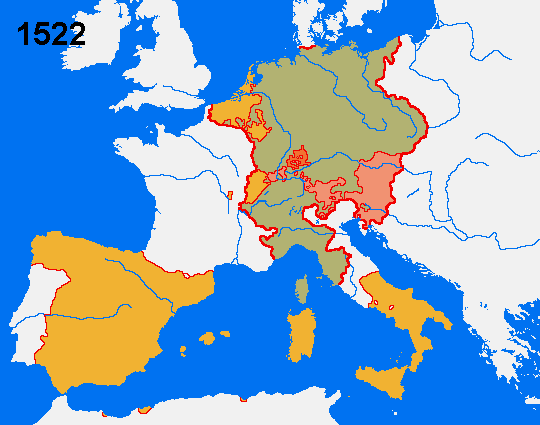
 = Domains of the Spanish Habsburgs
= Domains of the Spanish Habsburgs
 = Domains of the Austrian Habsburgs
= Domains of the Austrian Habsburgs |
 = Austrian territorial gain 1520
= Austrian territorial gain 1520
 = Other parts of the Holy Roman Empire
= Other parts of the Holy Roman Empire |
Charles V who inherited the Burgundian lands in 1506, Spain and Both Sicilies
in 1516 and the Austrian hereditary lands together with the Holy Roman Empire's
throne in 1519, also had a brother named Ferdinand who according to German
custom had an equal share of the government of the Habsburg lands within the
Holy roman empire. A partition of the vast domains was therefore to take
place 1521-22 so that Ferdinand got the Austrian hereditary lands (which had
been expanded with WŁrttemberg in 1520) while Charles V got the rest. This
meant that the Habsburg domains had been split between a Spanish and an Austrian
branch of the dynasty.
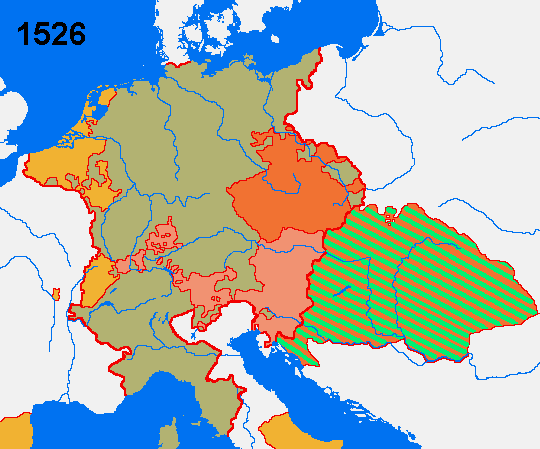
 = Domains of the Spanish Habsburgs
= Domains of the Spanish Habsburgs
 = Domains of the Austrian Habsburgs
= Domains of the Austrian Habsburgs |
 = Bohemian crown
= Bohemian crown
 = Other parts of the Holy Roman Empire
= Other parts of the Holy Roman Empire
 = Hungarian crown
= Hungarian crown |
In 1520 the Austrian archduke Ferdinand married the sister to Louis II who
was king of Bohemia and Hungary. Louis was killed six years later in the
disastrous defeat at Mohacs against the Turks. Ferdinand was elected to
succeed Louis in Bohemia and also in the Hungarian part kingdom of Croatia
But Hungary proper was divided between supporters to Ferdinand and the
Transylvanian vojvod JŠnos Zapolya who had Turkish backing. A prolonged
civil war erupted and Ferdinand would never gain control over all Hungary.
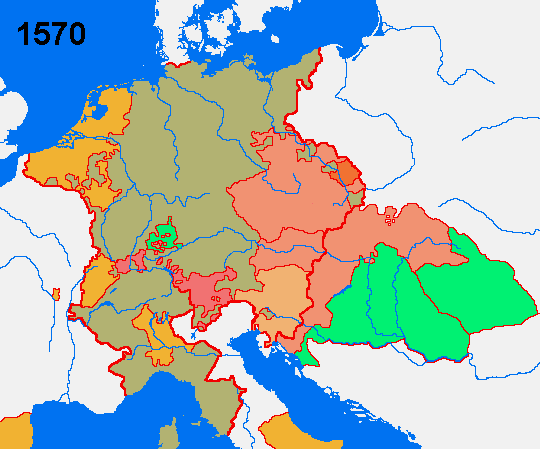
 = Domains of the Spanish Habsburgs
= Domains of the Spanish Habsburgs
 = Possessions of the Austrian line
= Possessions of the Austrian line
 = Possessions of the Styrian line
= Possessions of the Styrian line
 = Possessions of the Tyrolean line
= Possessions of the Tyrolean line |
 = Other parts of the Holy Roman Empire
= Other parts of the Holy Roman Empire
 = Austrian territorial gain 1532
= Austrian territorial gain 1532
 = Austrian territorial losses
= Austrian territorial losses
|
Ferdinand's attempt to win Hungary's crown met such resistance from the
Turks that Vienna was laid under siege by them in 1529. In the meantime had
profound changes occurred in Germany where the ideas of Martin Luther spread
rapidly. Ferdinand was not as hostile to these as his brother Charles V and
the Protestant faith set root in the Austrian hereditary lands. Because
Charles V gave priority to his Spanish realm was Ferdinand often left in
charge of Germany and in 1531 was he elected to Roman King and thus the
designated successor to Charles V as Holy Roman Emperor (which occurred in 1556).
WŁrttemberg was retuned to its previous duke in 1534, but would remain under
Austrian overlordship to 1599. The Silesian duchy of Oppeln, which was
subordinated to the Bohemian crown, came on the other hand under direct Habsburg
rule in 1532 when its reigning duke died without heirs. The long war over the
Hungarian crown was decided in 1541 when the Turks conquered the central third
of the Hungarian kingdom. The two claimants of the throne had to settle with
one third each and the Turks gave the title King of Hungary to Ferdinand in
exchange of an annual tribute while the son to JŠnos Zapolyas was given the
title prince of Transylvania as a Turkish vassal. A Formal peace was however
noted concluded until 1570.
Before that had Ferdinand died in 1564 and the Austrian hereditary lands
were partitioned between his three sons. The oldest son Maximilian received
Austria proper as well as becoming king of Bohemia and Hungary, and Holy
Roman Emperor. He was leaning towards Protestantism but remained catholic
throughout his life. Inner Austria (Styria, Carinthia and Carniola) went
to Charles who believed in religious freedom. Further Austria (Tyrol and the
Swabian possessions) was inherited by Ferdinand II who used force to suppress
Protestantism in his territories. With this had the Austrian branch of the
house of Habsburg been split in a Austrian, Styrian and a Tyrolean line.
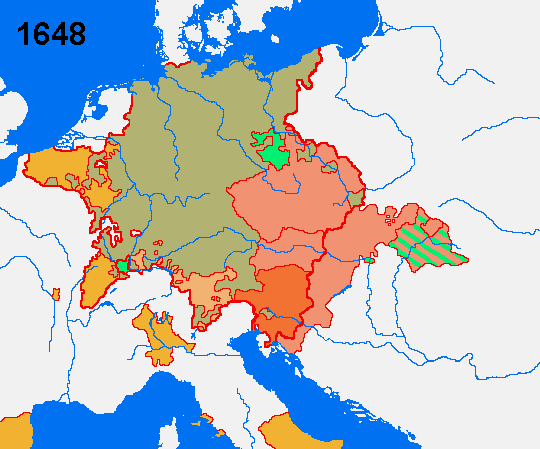
 = Domains of the Spanish Habsburgs
= Domains of the Spanish Habsburgs
 = Domains of the Austrian Habsburgs
= Domains of the Austrian Habsburgs
 = Possessions of the younger Tyrolean line
= Possessions of the younger Tyrolean line
|
 = Other parts of the Holy Roman Empire
= Other parts of the Holy Roman Empire
 = Austrian territorial gain 1618
= Austrian territorial gain 1618
 = Temporary losses 1621-29 and 1645-48
= Temporary losses 1621-29 and 1645-48
 = Austrian losses 1620, 1635 and 1648
= Austrian losses 1620, 1635 and 1648 |
The tolerant archduke Charles of Inner Austria was succeeded in 1590 by his
son Ferdinand who had been educated by Jesuits and he prohibited Protestantism
in his territories. Also in Austria proper had a younger generation of Habsburg
suppressed Protestantism and when this line became extinct in 1618 were they
succeeded by Ferdinand who completed their work. The Tyrolean line had become
extinct already in 1602 and its territories had then been united with Austrian
line. But they were granted to Ferdinand's brother Leopold in 1625 (after a short
rule by their cousin Albrecht 1620-21).
Ferdinand's struggle against Protestantism would however lead the break out of
the Thirty Years' War in 1618. The direct cause was an insurrection in Bohemia,
which Ferdinand only managed to suppress with support from other German states.
This support was costly and led to the permanent secession of Lusatia to Saxony
(confirmed 1635 in the Peace of Prague). Swedish and French intervention in the
war spoiled Ferdinand's ambitions and resulted in a considerable weakening of
the Holy Roman Emperor's power in the Westphalian Peace of 1648, although Austria's
territorial losses were modest (Sundgau at the Rhine was ceded to France). The
Hungarian border was however put under pressure during this period when the
princes of Transylvania waged war against the Habsburg in a effort to protect the
rights of the Hungarian protestants. Transylvania temporarily conquered several
counties in Northern Hungary 1621-29 and 1645-48. The Turks had also conquered a
small area along the Danube in 1620. But their right to tributes from the Habsburgs
had been lost after a Thirteen year long war that ended in 1606.
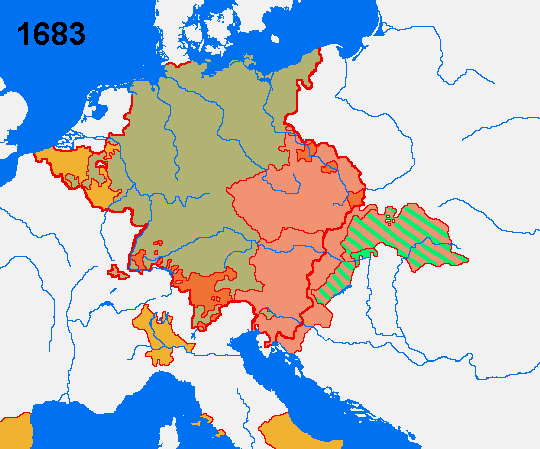
 = Domains of the Spanish Habsburgs
= Domains of the Spanish Habsburgs
 = Domains of the Austrian Habsburgs
= Domains of the Austrian Habsburgs
 = Other parts of the Holy Roman Empire
= Other parts of the Holy Roman Empire |
 = Territorial gains 1653, 1665 and 1675
= Territorial gains 1653, 1665 and 1675
 = Territorial loss 1664
= Territorial loss 1664
 = Occupied by the Turks 1683
= Occupied by the Turks 1683 |
After the Westphalian Peace was Habsburg control over Silesia
strengthened
when the last important Silesian duchies were returned to the Bohemian crown
1653 and 1675 after the extinction of their ruling houses. Between these
events had also the Habsburg line that ruled Further Austria with Tyrol died
out whereupon all hereditary Austrian lands were ruled by one person. The
Hungarian border continued to cause problems and in a humiliating peace in
1664 was another area along the Danube ceded to the Turks. The Ottoman Empire
would finally reach its largest extent when they supported a Hungarian rebellion
and occupied large parts of Habsburg controlled Royal Hungary. The conflict
culminated 1683 with the Turk's second siege of Vienna, which however failed
just like the first one had done in 1529.
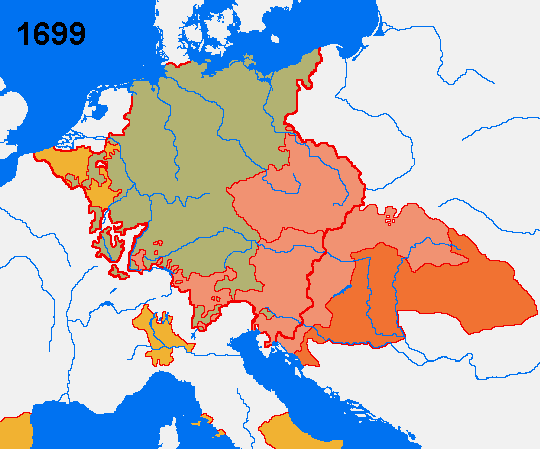
 = Domains of the Spanish Habsburgs
= Domains of the Spanish Habsburgs
 = Other parts of the Holy Roman Empire
= Other parts of the Holy Roman Empire |
 = Domains of the Austrian Habsburgs
= Domains of the Austrian Habsburgs
 = Austrian territorial gain 1699
= Austrian territorial gain 1699 |
The Turkish defeat outside Vienna 1683 initiated a Christian war of reconquest
of the Balkans which would last for sixteen years. Buda was conquered 1686 and two
years later fall Belgrade. The Turks managed to retake Belgrade but suffered a
great defeat at Zenta in 1697. In the following peace of Karlowitz in 1699
were the Turks forced to cede most of the territory of the Historic kingdom
of Hungary. The peace was a relatively mild one, and this was because of a
desire from the Austrians the finish the war before the expected War of the
Spanish Succession erupted. The Spanish branch of the house of Habsburg
would soon die out and both Austria and France made claims to inherit the vast Spanish realm.
The history of Austria continues on this page. |

